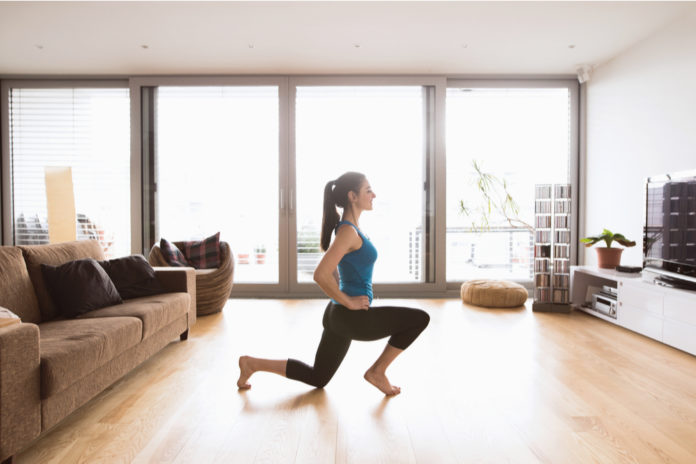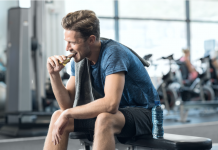The concept of functional fitness may be a bit elusive, because so many different exercise schools (think CrossFit, boot camps, etc.) claim their style of training is functional in nature.
Potentially, they are all correct because according to various fitness professionals, functional fitness exists on a continuum. What is functional training, really?
This article will cover not only that, but will discuss its importance. It also breaks down a functional workout that can be completed at home, in a gym, or even outside!
What Is Functional Training?
Functional training is based on a framework that suggests being able to perform everyday activities (such as cooking, personal care, and household chores) require the ability to perform certain functional exercises (like walking, stair climbing, and standing up from a sitting position). These functional movements are based on utilizing physiological reserve, aka strength, endurance, flexibility, and balance.
In a more complex definition, functional fitness is having the physiologic capacity to perform normal, everyday activities safely and independently without undue fatigue. However, the definition is sometimes broadened to encompass exercises that assist with daily activities. This includes tasks like getting up off the floor, carrying heavy objects, and putting something on a shelf.
Why has this term gained so much popularity and traction in recent years?
The main reason for its newfound admiration stems from the fact that modern society often does not cater towards naturally incorporating movement patterns that improve functional fitness capacity.
Many modern lifestyle habits have diminished opportunities to easily and conveniently participate in functional activities. These include:
- Escalators
- Valet parking
- Prolonged sitting
To counter these fitness blocks, schools of exercise have incorporated functional exercises into their models. Thankfully so, because functional fitness is vital for longevity.
Benefits of Functional Fitness
While there are many, the National Exercise and Sports Trainers Association indicates six major benefits of functional fitness including:
- Increases the ease of activities of daily life
- Low impact in nature
- Increases flexibility, balance, posture, and coordination
- Subdues joint pain
- Reduces risk of energy
- Increases strength, especially in people who are new to exercising
Further benefits are similar to the effects of general exercise such as walking and jogging that elevate heart rate. Some of these include reduced blood pressure, cholesterol, and risk of chronic disease like cancer and heart disease.
Many exercises can be modified to build functional fitness while increasing strength and cardiorespiratory health. In general, such a combo will inevitably help one perform daily tasks with more ease.
Who might benefit most?
- Everybody: This type of training is intended to replicate similar movements humans perform every day. So, truly, anyone of all fitness levels can stand to practice to help prevent injury and increase flexibility, balance, and coordination.
- Seniors: Seniors tend to be more prone to injuries, ailments, aches, and pains that need rehabilitation to gain mobility and strength. Correcting these health issues can help reengage seniors to regular daily activities. Because functional exercises are low impact and designed to promote the movement of daily life, they are a wonderful exercise option and should be encouraged in this population regularly.
- Injured Persons: Similar to above, injured persons often need to reduce the intensity of their workouts. While important to rest the injured body part, it’s prudent to strength train the rest of the non-injured body to maintain some muscle and metabolism. Training functionally is a great framework to continue exercising and staying active through rehabilitation.
Functional Workout Example
Before offering a coherent workout, below breaks down why such exercises are functional in nature. Explanations are also provided on how to modify the exercises to current abilities.
Squats
A squat mimics sitting in a chair and then standing back up.
To make this exercise easier, squat into a chair that is higher than parallel to a 90 degree sitting position. Increase difficulty by adding a weighted barbell amongst many other specific techniques.
Push-Ups
Push-ups essentially mirror pushing the body up from another surface.
To make it easier, put knees on the ground and cross the ankles, lifting them off the ground. As strength builds, shift into push-ups with only feet on the ground. Eventually, graduate to high difficulty by executing incline and decline push ups.
Step-Up/Downs
These are similar to getting down from a high seat or descending set of stairs. They are easier the lower the step surface (such as step block, home step stool, stair).
Meaning, make this movement easier by using a surface less than one foot off the ground. Progress to more difficult by increasing the surface height, up to four feet and even higher in some cases!
Back Rows
Back rows mimic pulling objects out of the trunk or moving laundry from the washer to the dryer. The easiest version of this movement simply involves these steps:
- Sit in a chair at about 90 degrees if possible
- Reach arms out as far as possible in front
- Pull arms back in a controlled fashion, squeezing the back simultaneously for increased mind-muscle-connection
A difficult version can be performed on a specific resistance machine. For greater difficutly, add a barbell or dumb bell(s).
Stationary Lunges
These lunges mirror another method of getting up from the ground. It also heavily promotes mobility in the knee joint, which is crucial for optimal functionality.
Make this easier by decreasing squat depth. Or, increase difficulty by squatting completely and adding free weight with barbell or dumbbells.
Deadlifts
Deadlifts are similar to bending over to reach something off the ground, pick it up, and stand back up straight. They recruit many muscles within the body and are debatably the most effective and functional exercise of all. Not necessarily because it mimics most daily activities, but because it requires many different muscle groups. In turn, deadlifts have big potential to greatly strengthen musculature.
Adjust difficulty with these tips:
- Make deadlifts easier by slowly performing the exercise using only body weight.
- Make it moderately difficult by using a trapeze bar if available.
- Make it even harder by adding weight to a barbell or utilizing dumbbells when executing.
Posterior Cross-Body Triceps
These mimic reaching and scratching an itch in the middle of the back.
Reach an arm above the head and bend it at the elbow, reaching as far down the back as possible. Then, bend it back straight, once again, at the elbow.
Planks
Planks mirror engaging the core muscles required for many activities of daily living. Complete regular, side, or reversed planks for a wider variety of functional exercise choices.
Planks are made easier by placing one or both knees on the ground. The movement becomes harder once lifting a limb or an arm and a leg, as it recruits more muscles to help hold increased weight.
While this is not an exhaustive list, it provides a solid start. Incorporate one to two of these movements into training sessions or focus an entire training session towards functional movements.
Consider training goals, current training cycle, upcoming performances, competitions, and/or races when deciding on the best plan of action. Also consult with a professional trainer or coach with questions to ensure an effective, safe plan.
Sample Workout Featuring Functional Fitness Exercises
*Perform 3-4 sets of 10-15 repetitions; go through each exercise consecutively to form a set
~Set: Round or the number of total times repetitions are performed (aim for the 3 to 4 range)
~Repetition: Number of times the exercise is performed within a single set (aim for 10 to 15 reps)
- Deadlifts
- Squat
- Plank
- Back row
- Stationary lunges (each leg)
- Tricep movement (each arm)
- Step-ups/downs
- Push-ups
Use these simple tips to make this workout most effective:
- Focus on form
- Perform the movements at a slow to moderate pace
- Optimize mind-muscle-connection
- Think about a daily activity that mirrors the exercise and/or uses the same muscles and form while performing it. This will help translate proper form from executing the exercises to daily activities of living.
The Main Takeaways
Despite functional fitness training becoming a trendy buzzword recently, it holds strong merit. Functional fitness aims to strengthen the muscles required for activities of daily living. It does so by utilizing exercises that mimic the form, hinge, fluid movement, and many more of the activities mentioned.
While especially beneficial for seniors and injured persons, it is prudent for everyone to engage in at least once a week. Moreover, there are a variety of movements to choose, and the deadlift may be the most effective exercise of all.
Again, consult personal trainers or certified coaches when developing a fitness program to ensure validity, effectiveness, and safeness.
References:
Davis N. Why Functional Fitness Is Important for Everyone. www.healthline.com/health/fitness/functional-fitness-adults.
Liz. 6 Benefits of Functional Training: Should You Give It a Try? Personal Trainer Certification, Nutrition Courses, Fitness Education. www.nestacertified.com/benefits-of-functional-training/.









